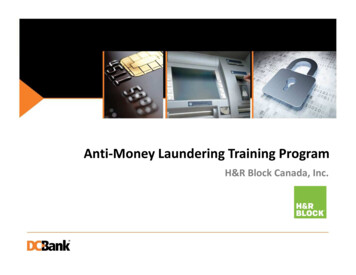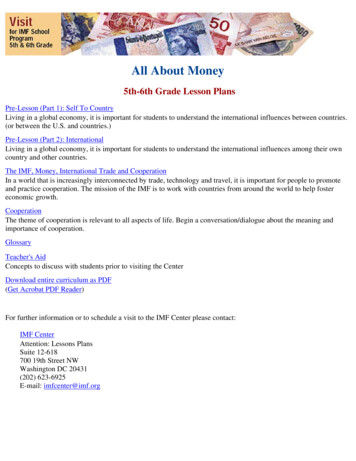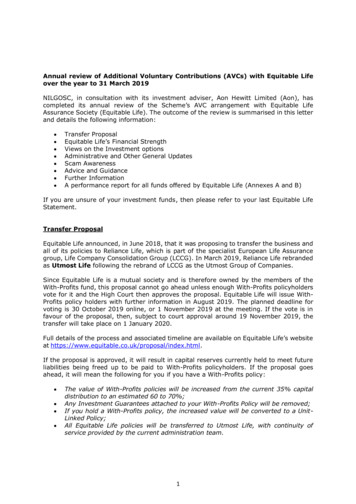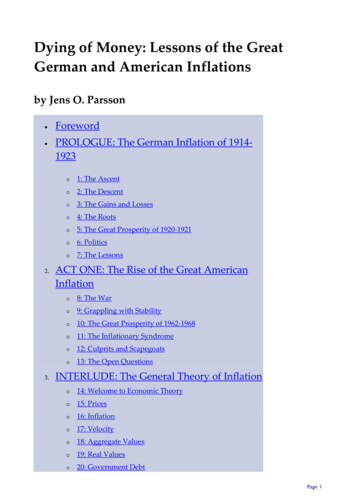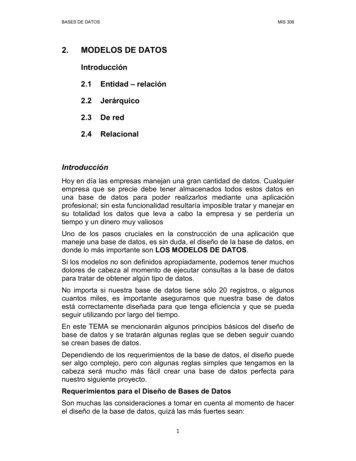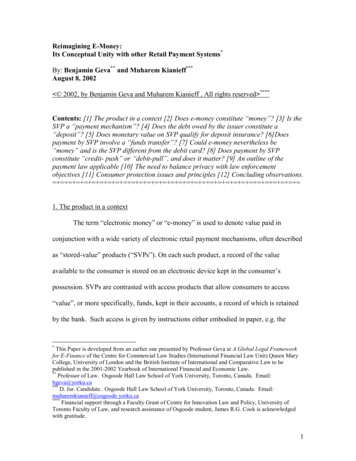
Transcription
Reimagining E-Money:Its Conceptual Unity with other Retail Payment Systems*By: Benjamin Geva** and Muharem Kianieff***August 8, 2002 2002, by Benjamin Geva and Muharem Kianieff , All rights reserved ****Contents: [1] The product in a context [2] Does e-money constitute “money”? [3] Is theSVP a “payment mechanism”? [4] Does the debt owed by the issuer constitute a“deposit”? [5] Does monetary value on SVP qualify for deposit insurance? [6]Doespayment by SVP involve a “funds transfer”? [7] Could e-money nevertheless be“money” and is the SVP different from the debit card? [8] Does payment by SVPconstitute “credit- push” or “debit-pull”, and does it matter? [9] An outline of thepayment law applicable [10] The need to balance privacy with law enforcementobjectives [11] Consumer protection issues and principles [12] Concluding observations. 1. The product in a contextThe term “electronic money” or “e-money” is used to denote value paid inconjunction with a wide variety of electronic retail payment mechanisms, often describedas “stored-value” products (“SVPs”). On each such product, a record of the valueavailable to the consumer is stored on an electronic device kept in the consumer’spossession. SVPs are contrasted with access products that allow consumers to access“value”, or more specifically, funds, kept in their accounts, a record of which is retainedby the bank. Such access is given by instructions either embodied in paper, e.g. the*This Paper is developed from an earlier one presented by Professor Geva at A Global Legal Frameworkfor E-Finance of the Centre for Commercial Law Studies (International Financial Law Unit) Queen MaryCollege, University of London and the British Institute of International and Comparative Law to bepublished in the 2001-2002 Yearbook of International Financial and Economic Law.**Professor of Law. Osgoode Hall Law School of York University, Toronto, Canada. Email:bgeva@yorku.ca***D. Jur. Candidate. Osgoode Hall Law School of York University, Toronto, Canada. l support through a Faculty Grant of Centre for Innovation Law and Policy, University ofToronto Faculty of Law, and research assistance of Osgoode student, James R.G. Cook is acknowledgedwith gratitude.1
cheque, or by electronic means, e.g. the debit-card, initiating an electronic funds transfer(“EFT”). An SVP may be in the form of either “electronic purse”, in which the value is“loaded” on a card, or “digital cash”, in which value is “loaded” on computer-software.Typically, a card-based product provides the consumer with an integrated-circuit (IC)card containing a microprocessor chip, namely a “smart card”, which is used at a publicaccess terminal, such as an ATM/ABM or at a point of sale (POS). At the same time, asoftware-based product operates via a personal computer, namely, a terminal to which theconsumer has proprietary access.1An SVP product may either be single or multi-purpose, may operate in eitherclosed or open systems, may or may not be restricted to a geographic area (small or big),may be single or multi-currency, and may be issued by either a single or multiple-issuer.As well, an SVP product may be offline unaccountable, offline accountable, or onlineaccountable.2 When neither transaction information nor resulting balance is transmittedfrom the product to a central facility, the product is offline unaccountable. Wheretransmission to a central facility occurs, the product is accountable; it is onlineaccountable when transmission is simultaneous with each use and is offline accountablewhen information is transmitted to the central facility only periodically. In fact, an onlineaccountable is indistinguishable from an access product. It is only an offlineunaccountable system that is fully stored-value and is not an access product. An offlineaccountable system is hybrid, combining features of both types of products.1See in general, Bank for International Settlements, “Security of Electronic Money”, (CPSS PublicationsNo. 18) (Basle: Aug . 1996); Bank for International Settlements, “Implications for Central Banks of theDevelopment of Electronic Money” (Basle: Oct. 1996); and S. Chinoy, “Electronic Money in ElectronicPurses and Wallets” (1997), 12 BFLR 15.2This division follows that which was proposed by the US Federal Reserve Board in Electronic FundTransfers (Proposed Rules), 61 Fed. Reg. 19, 696 (May 2, 1996).2
Parties to an e-money payment are the issuer, the payor, the payee and theacquirer. Other participants in the transaction are a system operator and, possibly, one ormore intermediary institutions. In a single issuer system the issuer is usually also thesystem operator. In a typical scenario, value issued by the issuer (possibly through aparticipating institution) and loaded on the payor’s device is transmitted to the payee’sdevice or terminal from which it can be deposited to the acquirer and ultimately presentedto the issuer for redemption through normal banking channels. The payee may be either amerchant or, in a “person-to-person” payment, another consumer.Some view the SVP as the ultimate saviour to deliver the long-waited cashlesssociety.3 At the same time, market penetration of e-money products has not been all thatimpressive and decisive as originally hoped by their promoters. Undoubtedly, confidencein the reliability and security of the products, in conjunction with adequate legalprotections, are likely to enhance the level of acceptance. Nevertheless, doubts persist asto the strength of the business case underlying the SVP. Possibly, particularly indeveloped economies, consumer needs are well met by the existing mix of accessdevices, credit and debit facilities, and cash, so that the need for stored-value products arenot all that obvious. Presumably, SVPs are likely to flourish in circumstances whereinadequate communication facilities preclude the efficient development and use of accessproducts.4 Or else, they are likely to be popular where cash in correct denominations is3For e-money as the culmination of the evolutionary process of payment media see e.g. O.E.Akindemowo, “The Fading Rustle, Chink and Jingle: Electronic Value and the Concept of Money” (1998),21 UNSW LJ 466. A visionary view of private electronic currency systems is presented by KL. Macintosh,“How to Encourage Global Economic Commerce: The Case for Private Currencies on the Internet” (1998),11 Harvard Journal of Law and Technology 733. See also M. Kianieff, “Show Me the Money! A CriticalEvaluation of Laissez-Faire Internet Currencies” (2002), 17 BFLR 215.4Generally speaking, inadequacy of communication facilities may reflect the general situation in a giveneconomy. Alternatively, it may be inherent in the nature of the particular business establishment, as for3
not easily available, whether as a means of payment or receipt of change. As well, as arepetition of the historical evolution of the multi-purpose credit card, a business case for amulti-purpose product may be substantiated in an environment in which single purposeproducts, such as telephone and subway cards proliferate. Finally, SVPs may be given achance to prove their efficiency in an environment where payment mechanisms,including cash, are priced and respective users are made to bear their full cost.5Regardless, the operation of SVPs has raised interesting legal issues. Thesignificance of these issues goes beyond the products themselves and underliesfundamentals relating to payment mechanisms, particularly in the context of retailpayment systems.6 The ensuing discussion is an analysis of such issues and will attemptto use existing legal concepts to show how they can be used in the context of E-Moneyand where they may have difficulty being used. Issues to be explored relate to the conceptof money, the meaning and scope of the payment mechanism, the legal nature of thedeposit as well as of the funds transfer, whether deposit insurance can be applied toSVPs, the distinction between credit-push and debit-pull funds transfers, payment lawswhich apply to SVPs (in this context, the feature of a guaranteed payment is highlighted),consumer privacy, needs for law enforcement and consumer protection principles that canbe applied.example, a moving one, such as a taxi. Finally, the cost of communication may be prohibitive due to eitherdistance or low value of the transaction.5In fact, costs are associated with all payment mechanisms. This includes the cash payment system, as thedistribution and upkeep of cash in quantity and quality required to meet actual demand is quite an extensiveoperation. However, the cost of the cash system is not borne directly by cash users and it is conceded herethat whatever economic justification may exist, it may politically be inconceivable to envision such costsbeing passed on to users.6For e-money products and selected review of issues see also ABA’s Task Force on Stored-Value Cards,“A Commercial Lawyer’s Take on the Electronic Purse: An Analysis of Commercial Law IssuesAssociated with Stored-Value Cards and Electronic Money” (1997), 52 Bus. Law. 653; and L. Edgar4
2. Does e-money constitute “money”?7Economists define money as anything that is widely accepted in payment forgoods, used as a medium of exchange, and expressed as a standard unit in which pricesand debts are measured.8 Such a conception9 was favourably received in Moss v.Hancock10, in which “money” was defined to mean “that which passes freely from handto hand throughout the community in final discharge of debts being accepted equallywithout reference to the character or credit of the person who offers it and without theintention of the person who receives it to consume it ”.Mann finds the adoption by lawyers of the economic point view as unsatisfactory.In his view, the economic definition is broad enough to cover mere bank accountbalances, which is unacceptable to the lawyer. For Mann, “in law, the quality of money isto be attributed to all chattels which, issued by the authority of the law and denominatedwith reference to a unit of account, are meant to serve as universal means of exchange inthe State of issue”.11 E-money is not a chattel, and if for this reason alone it will not fitinto Mann’s definition.Nonetheless, it seems that Mann unjustifiably both expands the economicdefinition and restricts the legal one. Thereby, he introduces an unnecessary gap that doesnot really exist. The economic inclusion of balances in demand deposits focuses on their“Electronic Money”, in C. Reed, I. Walden and L. Edgar (eds.), Cross-Border Electronic Banking 2nd ed(London, Hong Kong: LLP, 2000), 201.7For this aspect, see B. Crawford, “Is Electronic Money Really Money?” (1997), 12 BFLR 399.8See for example, D.H. Robertson, Money (Chicago: University of Chicago Press, 1962), 2-3.9As specifically taken from the “Money” entry in the Encyclopaedia Britanica, citing F.A. Walker,“Money, Trade, and Industry” p. 4.10[1899] 2 QB 111, 116.11F.A. Mann, The Legal Aspect of Money, 5th ed. (Oxford: Clarendon Press, 1992), 8, and see in general, at5-28.5
availability for immediate withdrawal as money. In other words, it refers to the quantityof money and not the quality of what constitutes money; it does not address themechanism that converts such balances to a medium of exchange. As for the legaldefinition, the chattel requirement is quite unfortunate. It may be a good description ofwhat has been money from its inception to the present era. Nevertheless, it does notfollow that this feature is inherent in the concept of money, particularly in an era in whichwe move into the electronic age.12 Similarly, the issue of “money” by the State is aculmination of a historical process. Yet, historically, money has not always been issuedby the State, so that even more than the chattel feature, the State issue is not necessarily afeature inherent in the concept of money.13 True, as the culmination of a historicalprocess, money currently consists of coins and bank notes issued by the State or itscentral bank.14 This fact should not colour our own understanding of the concept ofmoney as transcending any particular historical stage in its actual evolution.Accordingly, the adoption of the economic definition by Moss v. Hancock15appears to us to be satisfactory. To this end, prima facie, a third party’s obligation whoseacceptance in payment of a debt confers an absolute discharge on the debt meets thisdefinition, provided it circulates, namely, passes freely from hand to hand, for the sole12Similarly, repeated references in earlier cases to the banker’s duty to comply with customer’s orders onpaper instruments such as cheques or other types of bills of exchange should not be taken to exclude abank’s duty to comply with customer’s orders submitted electronically. Rather, such references correspondto the particular technology of the time. See e.g. Joachimson v. Swiss Bank [1921] 3 KB 110 (CA) whereAtkin LJ speaks at 127 of the “added, or superadded obligation of the bank to honour the customer’sdrafts ”, as well as United Dominions Trust, Ltd, v. Kirkwood [1966] 1 All ER 968 (CA) where LordDenning MR states at 975 that “no person can be considered a banker unless he handles cheques as freelyas cash”. Emphasis is added.13For a critical discussion of the state theory of money, see A. Nussbaum, Money in the Law: National andInternational (Brooklyn: The Foundation Press, 1950), at 5-10.14For this evolutionary process see B. Geva, “From Commodity to Currency in Ancient History – onCommerce, Tyranny, and the Modern Law of Money” (1987), 25 Osgoode Hall LJ 115.15See text around notes 8-10, above.6
purpose of discharging debts.16 Potentially, e-money could meet these requirements. Thefact that it is a medium of exchange only for small denomination transactions is not anobstacle; ceilings for the use of certain currency denominations issued by the State mayeven be provided by law.17However, for each e-money product to be “money”, the stored or loaded valuemust be a universal medium of exchange, as measured by wide acceptance amongcreditors. Obviously, the degree of acceptability of each e-money product in the marketplace is a question of degree, not always easily ascertainable. To that end, a fewobservations could be made. First, value loaded on a single-purpose product should notbe regarded as “money”; rather it is an advance payment for the goods or services to bebought with it. A telephone or New York subway card is a case to the point. Conversely,and this is the second observation, value stored in a multi-purpose product, acceptedacross a country by numerous merchants, is likely to constitute money.Third, by itself, the free convertibility of stored value to cash or its equivalent,such as a cash balance in a demand deposit in a bank, does not necessarily indicate thatthe product is “money”. Free convertibility may however be taken into account as part ofthe overall picture in border cases of restricted or limited use products, in that their valuemay not otherwise qualify as money. Relevant restrictions or limits relating to the use ofan e-money product may be either geographic, such as acceptance solely in one shoppingmall or one small town, or by reference to the number of participating creditors. Whenthe degree of restrictions or limits is not considered to be substantial, free convertibilitymay arguably support the conclusion that the value is “money”, even if by itself, the wide1617The fulfilment of this “circulation” requirement is re-visited in Section 7, below.See e.g. in Canada, s. 8(2) of the Currency Act, RSC, 1985, c. C-52, as am. by S.C. 1999, c.4, s.12(2).7
acceptability of the e-money product has not been satisfactorily established. Nevertheless,in determining whether stored value of a given e-money product is “money”, we submitthat in connection with single-use e-money products redeemability to cash will notsuffice, while for widely used multi-purpose products it will not be necessary.Against the view that e-money may be considered money several principalobjections are raised. First, e-money does not provide a distinct unit of account. Second,payment with e-money may not be anonymous since the third party obligor may keep arecord of each transfer. Third, e-money may be created other than by withdrawal from areservable deposit with a commercial bank so as to undermine the central bank’s hold onmonetary policy. Fourth, e-money cannot constitute “legal tender”.All four objections can however be met. Regarding the first two, neither “unit ofaccount” nor anonymity are fundamental requirements for something to constitute“money”, as opposed to salient features of what is traditionally recognized today as“money”. First, the unit of account could be external to the money itself; that is, moneymay be required to be stated quantitatively, though possibly by reference to a yardstickthat may be external, and not inherent in the money itself. Accordingly, the denominationof e-money in standard units of a national currency does not diminish its position as“money” in its own right. Second, regarding anonymity, historically, the transition fromcoins to paper money involved a degree of loss of anonymity, since individual banknotesmay be identified by number and recorded by a party to a payment transaction. True, inan e-money situation the potential recording is by a third party; this increases the loss ofanonymity but such loss may be a mere question of degree. Furthermore, loss ofanonymity may not be substantial in the “offline unaccountable” products. On the other8
hand, as technology advances, anonymity may further be eroded even with regard topayment in paper money. Such will be the case if individual banknotes are to beidentified with radio-frequency identification tags (“RFIDS”), each consisting of a(batteryless ) microchip and antenna encapsulated in plastic, capable of being“interrogated” and tracked by a remote reading machine operating at the right radiofrequency.18 Thus, loss of anonymity is quite a precarious test for whether somethingdoes constitute “money”.The third objection is based on the thesis that the electronic revolution may leadto a "decoupling” of the operations of the central bank from markets in which financialclaims are created and transacted. Stated otherwise, the thesis is that claims people use inorder to execute transactions may no longer be restricted to claims backed one-for-one bybank deposits. Rather, they expand to cover claims against commercial players whoseissuance is not influenced by the monetary policy of the central bank.19 However, even ifrealistic, this objection fails to address the possible transformation of “money”. In theprocess, “money” is being transformed from predominantly an obligation of a centralbank to that of any other creditworthy issuer. For example, such an issuer could be thetelephone company, assuming value loaded on its cards may be used to purchase goodsand services from other retailers.20 True, the central bank’s position may be affected withthe evolution of technologies facilitating an increasing expansion of e-money; most18The Economist February 9th 2002, p. 69.See for example, The Economist April 27th 2002, p. 75, as to the use of mobile-phone account balances as“stored-value” used to pay for purchases of unrelated goods and services.20For the development of this line of argument see B.M. Friedman, “The Future of Monetary Policy: TheCentral Bank as an Army with Only a Signal Corps?” (Nov. 1999) 2:3 International Finance 321; B.M.Friedman, “Decoupling at the Margin: The Threat to Monetary Policy from the Electronic Revolution inBanking” (July 2000) 3:2 International Finance 261.199
notably, a substantial loss of seigniorage is to be involved.21 This impact is however nodifferent than that of all non-cash payment systems; it will require the introduction ofinnovations in the implementation of monetary policy,22 but does not undermine thecharacter of e-money as “money”.Finally, the fourth objection states that e-money is not “legal tender”. Possibly,the identification between legal tender and money is based on Mann who states that “[i]nthe absence of the creditor’s consent, express or implied, debts cannot be dischargedotherwise than by the payment of what the law considers as money, namely legaltender”.23 Nonetheless, not all money is “legal tender”24; as explained by Nussbaum,“[l]egal tender is money which a creditor is not privileged to refuse if it is tendered bya debtor in payment of his debt”.25 While Nussbaum overlooks the creditor’s right tostipulate in advance, expressly or by implication, a mode of discharge that excludespayment by legal tender, he correctly points out that there could be “money” which is notlegal tender. Historically, banknotes became “money” before they were elevated to “legal21“Seigniorage” is the monopoly profit of the issuer of currency. “When central banks came to bemonopoly suppliers of banknotes, seigniorage came to be reflected in the profits made by them andultimately remitted to their major or only shareholder, the government. Seigniorage can be estimated bymultiplying notes and coin outstanding (non-interest central bank liabilities) by the long-term rate ofinterest on government securities (a proxy for the return on central bank assets)”. See BIS, “Implications”(Oct. 1996), above note 1 at 15.22For the broader question of the central bank and monetary policy in the electronic age see in general,C.A.E. Goodhart, “Can Central Banking Survive the IT Revolution” (July 2000) 3:2 International Finance189.23Mann, above note 11 at 5-6.24See a statement to that effect in Reference re Alberta Legislation, [1938] SCR 100, [1938] 2 DLR 81 at116 (SCR) (Canada). Interestingly enough, under the Canadian Constitution Act, 1867, currency andcoinage, the issue of paper money, and legal tender, are enumerated as three distinct headings of federallegislative power. See Constitution Act, 1867 (UK), 30 & 31 Vict., c.3, ss. 91(14), (15) and (20), reprintedin RSC 1985, App. II, No.5. This reflects the distinct nature of each concept.25Nussbaum, above note 13, at 45-46.10
tender”,26 and the analogy between the historical private banknote issuing27 and e-moneyissuing is anyway quite tempting.In any event, it is interesting to note that, as concepts, “e-money” and “legaltender” are not inherently incompatible.28 A case to the point is the decision by Singaporeto embrace e-money as legal tender in 2008. Under an “electronic legal-tender system”every merchant and service provider will be required to accept e-money no matter whatthe price of the goods or services in question.29 Fundamental features of the plan havenot been unveiled yet. For example, it is unclear whether e-money will exclusively belegal tender, so that coins and bank notes are to be eliminated altogether. Furthermore, noinformation has been provided to identify the issuer of the e-money serving as legaltender. It is possible that the issuer could be the State or one of its organs. The interestingpossibility of e-money issued by the State will meet the second objection to viewing emoney as money. However, the scenario of a state-issued e-money is outside the presentdiscussion that focuses on privately issued e-money. For our purposes here, suffice it tosay that “e-money” could be “money” without being “legal tender”; actually, it is notinconceivable to have “e-money” as “legal tender”, which by itself is “money”.3. Is the SVP a “payment mechanism”?Elsewhere, one of the co-authors has described a payment mechanism as “anymachinery facilitating the transmission of money in the payment of a debt, which enables26Geva, above note 14, at 149 – 151.Macintosh, above note 3, at 744.28See e.g. J.B. Konvisser, “Coins, Notes and Bits: The Case for Legal Tender on the Internet” (1997), 10Harvard Journal of Law and Technology 321, proposing government issued e-money as legal tendercurrency.29See A. Creed, “E-Money to be Made Legal Tender in Singapore”, Newsbytes (20001226/Wires Asia,Online, Legal/Singapore/Photo) (26 Dec. 2000), online: www.newsbytes.com.2711
the debtor to avoid the transportation of money and its physical delivery to the creditor inthe discharge of the debt.” Its operation was stated to be “premised on the discharge of adebt by virtue of an authorized payment made by a third party, frequently a debtor’sdebtor”, whose debt to the debtor has been simultaneously discharged as well. Paymentby the third party may or may not be in specie. While it “is fundamentally a three-partyarrangement”, a payment mechanism can be expanded to include more participants,thereby “bringing about a further reduction of the physical transportation of money”.30The SVP appears to fall into this broad definition. Fundamentally, it operates todischarge the debt owed by the payor to the payee by means of payment to the payee,carried out by means of discharging a debt of the issuer to the payor, and generating adebt owed by the acquirer to the payee.31The view that the SVP is a “payment mechanism” can consistently be held withthe position that the e-money loaded on it is “money”. Indeed, as indicated, forsomething to constitute money, it must confer “final discharge” so as to be accepted inpayment “without reference to the character or credit of the person who offers it ”.32Effectively, this means that to be by itself money, a payment mechanism must conferabsolute discharge, so that no recourse against the payor is to be available to the payeeupon the default of the third party/pay master, in our case, the e-money issuer. Forexample, no such absolute discharge is presumed to exist in connection with cheques,bills of exchange and letters of credit; “[i]t is common ground that where a debt is ‘paid’by cheque there is a presumption that such payment is conditional on the cheque being honoured. If it is not honoured, the condition is not satisfied and the liability of the3031B. Geva, “The Concept of Payment Mechanism” (1986), 24 Osgoode Hall LJ 1, 3-10.See A.L. Tyree, “The legal nature of electronic money” (1999), 10 JBFLP, 273.12
[payor] to pay remains”.33 There is however no general presumption of conditionalpayment, and “[e]ach method of payment has to be considered in the light of theconsequences and other circumstances attending that type of payment.”34 As inconnection with the credit card35, it is reasonable to assume that parties intend an emoney product to provide absolute discharge of the underlying debt so that no recourseagainst the payor is available to the payee upon the default by the issuer. Consequently,as a payment mechanism providing for an absolute discharge, value loaded on an SVP(“e-money”) could simultaneously be money as well.In fact, this is exactly like the case of the traveller’s cheque; the latter is apayment mechanism, facilitating the non-cash transmission of money between a travellerand a merchant, which circulates in the discharge of debts so as to constitute “money”.As well, historically, one could argue that up to the end of the period during whichconvertibility to gold or another precious metal had been available, the banknote, that ispaper money, was a payment mechanism. And while instruments such as the bank draftor certified cheque may provide an absolute discharge, they do not constitute “money”since they do not circulate.4. Does the debt owed by the issuer constitute a “deposit”?With regard to the bank deposit, it is recognized that “[t]he money placed in thecustody of a banker is, for all intents and purposes, the money of the banker, to do with itas he pleases”, so that “the relation between banker and customer, as far as the pecuniary32Moss v. Hancock, supra note 10 at 116. See text at n. 9 above.Re Charge Card Services Ltd. [1988] 3 All ER 702 (CA) at 707.34Id.35For the credit card as conferring an absolute discharge, see Charge Card, id.3313
dealings are concerned, [is] that of debtor and creditor.”36 As well, with regard to thecontract underlying the bank deposit, “ it is admitted that there is added, or superadded,an obligation of the bank to honour the customer’s [instructions] to any amount notexceeding the credit balance at any material time”.37 This obligation is however subjectto the customer’s undertaking “to exercise reasonable care in executing his [instructions] ”38Arguably, this description fits e-money loaded on an SVP in the same way that itfits the traditional situation of monetary value deposited to a bank account, except that forvalue recorded on an SVP the account is “decentralized” or “distributed”.39 To the extentthat e-money constitutes “money”, it ought to be regarded as deposited in an account withthe issuer. It is only in connection with the single-purpose e-money products, and to apoint, restricted or limited-use such products, that e-money is to be regarded as anadvance payment, or prepayment, for relevant goods or services.40Moreover, one ought to bear in mind that the obligation represented on a SVP isone that is held by an issuer and can be decreased in increments as opposed to being aninstrument for which the payee must accept the entire amount. This facet of SVPs hasalready found expression in a number of U.S. states. For example, the State BankingDepartment of Texas has stated that it will consider Smart Cards to be subject to theTexas Sale of Checks Act since the issuer will be holding the funds of consumers whowill rely on the issuer to ensure that the card will be honoured by merchants when it is3637Foley v. Hill (1848), 2 HLC 28 at 36 and 45; 9 ER 1002, at 1005 and 1009 (HL).Joachimson v. Swiss Bank, above n. 12 at 127.38Ibid.Tyree, above note 31 at 276.40For e-money as “money”, see Section 2, above.3914
presented for payment.41 In addition, the State of Oregon has defined an electr
access terminal, such as an ATM/ABM or at a point of sale (POS). At the same time, a . unaccountable system that is fully stored-value and is not an access product. An offline accountable system is hybrid, combining features of both types of products. . products, such as telephone and subway cards proliferate. Finally, SVPs may be given a


